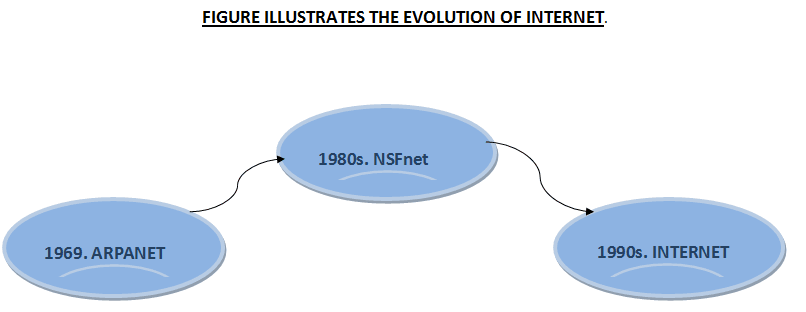Evolution Of Networking
Evolution of networking started way back in 1969 by the development of first network called Arpanet, which led to the development of internet.
ARPANET
v The Seeds Of Today’s Internet Were Planted In 1969,When U.S. Department Of Defense Sponsored A Project Named ARPANET(Advanced Research Projects Agency Network).
v The Goal Of This Project Was To Connect Computers At Different Universities And U.S. Defense.
v Soon, The Engineers, Scientists, Students And Researchers Who Were Part Of This System ,Began Exchanging Data And Messages On It.The Users Of This System Were Also Able To Play Long Distance Games And Socialize With People Who Shared Their Interests.
v ARPANET started with a handful of computers but it expanded rapidly.
NSF net
v In Mid 80’s ,Another Federal Agency, The National Science Foundation, Created A New ,High-Capacity Network Called NSFnet, Which Was More Capable Than ARPANET.
v NSFnet Allowed Only Academic Research On Its Network And Not Any Kind Of Private Business On It.
- So Many Private Companies Built Their Own Networks, Which Were Later Interconnected Along With ARPANET And NSFnet To Form Internet.
- It Was The Inter Networking .i.e., The Linking Of These Two And Other networks(ARPANET, NSFnet And Some Private Networks That Was Named Internet.
- The Original ARPANET Was Shut Down in 1990and The Govt. Funding For NSFnet Discontinued In 1995. But The Commercial Internet Services Came Into Picture, Which Are Still Running The Internet.
NEED FOR NETWORKING
Before getting into the technical details of computer networks, we must find out why people are interested in it and what makes it necessary for the survival of any organization in this competitive era.
Network Goals
Many organizations already have a substantial number of computers, often located far apart. For example, a company with many offices may have computers at each location to keep track of customer orders, monitor sales, and do the local payroll. Previously, each of these computers may have worked in isolation from others but at some point, management decided to connect them to gather information about entire company. In general we can refer to it as
(i) Resource Sharing. The aim is to make all programs. Data and peripherals available to anyone on the network irrespective of the physical location of the resources and the user.
(ii) Reliability. A file can have copies on two or three different machines, so if one of them is unavailable (hardware crash). For military, banking, air reservation and many other application it is of great importance.
(iii) Cost Factor. Personal computers have better price/performance ratio than micro computers. So it is better to have PC’s, one per user, with data stored on one shared file server machine.
(iv) Communication Medium. Using a network, it is possible for managers, working far apart, to changes at one end can be immediately noticed at another and hence it speeds up co-operation among them.
Application of Networks
Computers have made a major impact on the society as a whole but we will discuss only of the important ones.
- Sharing. The potential advantage of network is to provide an easy and flexible means of sharing. There are three distinct types of sharing :
(a) Peripherals. These are often expensive. It is impractical for each computer on the network to have both its laser printer (for all general printouts). A main frame may have one of easch connected to it allowing all users controlled access in a cost effective manner.
(b) User of multiuser system can share and exchange information in a number of ways. Examples are: sending electronic mail or having controlled access to some files or data base.
(c) In a traditional time sharing system, all control is performed centrally, if the processor fails then the entire system fails. In a network system, this need not be the case. The failure of one node should not have a ‘domain’ effect on the rest. This is called distributed control and is a very lively area of research at present.
- Access to remote database. Another major area of network use is access to remote database. It is easy for the average person sitting at his PC to make reservation for airplanes, trains, hotels and so on anywhere in the world instant confirmation.
- Communication facilities. A third category of potential widespread network use is a communication medium. It is possible for everyone , not just people in the computer business, to send and receive electronic mail. this mail is also able to contain digitized voice, still pictures and even moving television and video images.
Using computer network as a sophisticated communication system may reduce the amount of travelling done, thus saving energy. The information revolution is expected to change society as much as the Industrial Revolution did.
Advantages of networks:
v Share resources: Such as printers and scanners.this is cheaper than buying equipment for each computer.
v Can share software: Software can be installed centrally rather than on each machine. metering software can then be used to limit the no of copies being run at any one time.this is much cheaper than buying licenses for every machine.
v Share storage: being able to access files from any machines on the network.can share data.
v Improve communications : messages can be sent e.g. internal email
Disadvantages of networks:
v The system is more sophisticated and complex to run.this can add to costs and you may need specialist staff to run the network.
v If n/w’s are badly managed services can become unusable and productivity falls.
v If software and files are held centrally, it may be impossible to carry out any work if the central server fails.
v File security is more important especially if connected to WAN’S e.g. protection from viruses.
Post By: – Mrs. Kavita Kapoor
Computer Teacher
























Thank you this helps a lot